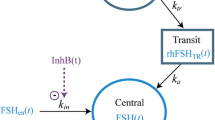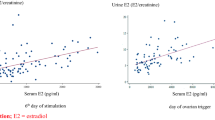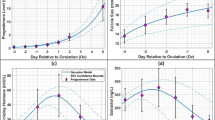Abstract
High serum follicle-stimulating hormone (FSH) levels have been associated with diminished ovarian reserve; however, the association between high urinary FSH and reduced natural fertility has yet to be established. We sought to characterize the relationship between a single or multiple measurements of early follicular phase urinary FSH and fertility. Women (n = 209), 30 to 44 years old with no history of infertility, who had been trying to conceive for less than 3 months, provided early follicular phase urine. Participants subsequently kept a diary to record bleeding and intercourse and conducted standardized pregnancy testing for up to 6 months. A subset of women (N = 95) collected urine on cycle day 3 for up to 6 cycles. Urine was analyzed for FSH and creatinine (cr) corrected. Proportional hazard models were used to calculate fecundability ratios (FRs). Urinary FSH levels across cycles from the same woman were highly correlated (adjusted intraclass correlation = .77); within-woman variance was 3-fold lower than variance among women. Women with an initial urinary FSH level <7 mIU/mg cr exhibited a nonsignificant reduction in the probability of pregnancy (adjusted FR 0.71, 95% confidence interval [CI]: 0.45–1.13), as did women with elevated urinary FSH (≥12 mIU/mg cr; adjusted FR 0.78, 95% CI: 0.46–1.32). Using the most recent or maximum urinary FSH value did not strengthen the association. In the general population, urinary FSH levels appear to be nonlinearly associated with fertility; however, broad CIs indicate a lack of statistical significance. Repetitive testing appears to be of little benefit.
Similar content being viewed by others
References
Abma JC, Chandra A, Mosher WD, Peterson LS, Piccinino LJ. Fertility, family planning, and women’s health: new data from the 1995 National Survey of Family Growth. Vital Health Stat 23. 1997;(19):1–114.
Hansen KR, Thyer AC, Sluss PM, Bremner WJ, Soules MR, Klein NA. Reproductive ageing and ovarian function: is the early follicular phase FSH rise necessary to maintain adequate secretory function in older ovulatory women? Hum Reprod. 2005;20(1):89–95.
Gougeon A, Chainy GB. Morphometric studies of small follicles in ovaries of women at different ages. J Reprod Fertil. 1987;81(2):433–442.
Faddy MJ, Gosden RG, Gougeon A, Richardson SJ, Nelson JF. Accelerated disappearance of ovarian follicles in mid-life: implications for forecasting menopause. Hum Reprod. 1992;7(10):1342–1346.
Henderson SA, Edwards RG. Chiasma frequency and maternal age in mammals. Nature. 1968;218(5136):22–28.
Roberts VJ, Barth S, el Roeiy A, Yen SS. Expression of inhibin/activin subunits and follistatin messenger ribonucleic acids and proteins in ovarian follicles and the corpus luteum during the human menstrual cycle. J Clin Endocrinol Metab. 1993;77(5):1402–1410.
Santoro N, Isaac B, Neal-Perry G, et al. Impaired folliculogenesis and ovulation in older reproductive aged women. J Clin Endocrinol Metab. 2003;88(11):5502–5509.
Fukuda M, Fukuda K, Andersen CY, Byskov AG. Characteristics of human ovulation in natural cycles correlated with age and achievement of pregnancy. Hum Reprod. 2001;16(12):2501–2507.
Hansen KR, Hodnett GM, Knowlton N, Craig LB. Correlation of ovarian reserve tests with histologically determined primordial follicle number. Fertil Steril. 2011;95(1):170–175.
Oosterhuis GJ, Lambalk CB, Michgelsen HW, de Koning CH, Vermes I, Schoemaker J. Follicle-stimulating hormone measured in unextracted urine: a reliable tool for easy assessment of ovarian capacity. Fertil Steril. 1998;70(3):544–548.
Liu JH, Kao L, Rebar RW, Muse K. Urinary beta-FSH subunit concentrations in perimenopausal and postmenopausal women: a biomarker for ovarian reserve. Menopause. 2003; 10(6):526–533.
Steiner AZ, Herring AH, Kesner JS, et al. Antimullerian hormone as a predictor of natural fecundability in women aged 30–42 years. Obstet Gynecol. 2011;117(4):798–804.
Jain T, Klein NA, Lee DM, Sluss PM, Soules MR. Endocrine assessment of relative reproductive age in normal eumenorrheic younger and older women across multiple cycles. Am J Obstet Gynecol. 2003;189(4):1080–1084.
Kesner JS, Knecht EA, Krieg EF Jr. Stability of urinary female reproductive hormones stored under various conditions. Reprod Toxicol. 1995;9(3):239–244.
Kesner JS, Knecht EA, Krieg EF Jr. Time-resolved immunofluorometric assays for urinary luteinizing hormone and follicle stimulating hormone. Anal Chim Acta. 1994;285:13–22.
R: A language and environment for statistical computing. R Foundation for Statistical Computing. 2009. http://www.R-project.org. Accessed December 6, 2011.
Lunn DJ, Thomas A, Best N, Spiegelhalter D. WinBUGS—a Bayesian modelling framework: concepts, structure, and extensibility. Stat Comput. 2000;10:325–337.
Cox DR. Regression models and life tables. J R Stat Soc B. 1972;34:187–220.
Stokes ME, Davis CS, Koch GG. The s x r Table. Categorical Data Analysis Using the SAS System. Cary, NC: SAS Institute Inc.; 2000.
Scarpa B, Dunson DB. Bayesian selection of predictors of conception probabilities across the menstrual cycle. Paediatr Perinat Epidemiol. 2006;20(suppl 1):30–37.
Arevalo M, Sinai I, Jennings V. A fixed formula to define the fertile window of the menstrual cycle as the basis of a simple method of natural family planning. Contraception. 1999;60(6):357–360.
Guo X, Carlin BP. Separate and joint modeling of longitudinal and event time data using standard computer packages. The American Statistician. 2004;58:16–24.
Backer LC, Rubin CS, Marcus M, Kieszak SM, Schober SE. Serum follicle-stimulating hormone and luteinizing hormone levels in women aged 35–60 in the U.S. population: the Third National Health and Nutrition Examination Survey (NHANES III, 1988–1994). Menopause. 1999;6(1):29–35.
Muasher SJ, Oehninger S, Simonetti S, et al. The value of basal and/or stimulated serum gonadotropin levels in prediction of stimulation response and in vitro fertilization outcome. Fertil Steril. 1988;50(2):298–307.
Jain T, Soules MR, Collins JA. Comparison of basal follicle-stimulating hormone versus the clomiphene citrate challenge test for ovarian reserve screening. Fertil Steril. 2004;82(1):180–185.
Bancsi LF, Broekmans FJ, Mol BW, Habbema JD, te Velde ER. Performance of basal follicle-stimulating hormone in the prediction of poor ovarian response and failure to become pregnant after in vitro fertilization: a meta-analysis. Fertil Steril. 2003;79(5):1091–1100.
van der Steeg JW, Steures P, Eijkemans MJ, et al. Predictive value and clinical impact of basal follicle-stimulating hormone in subfertile, ovulatory women. J Clin Endocrinol Metab. 2007;92(6):2163–2168.
Li H, Nakajima ST, Chen J, Todd HE, Overstreet JW, Lasley BL. Differences in hormonal characteristics of conceptive versus non-conceptive menstrual cycles. Fertil Steril. 2001;75(3):549–553.
Witt BR, Barad DH, Barg P, et al. Basal serum follicle stimulating hormone (FSH) and estradiol levels as predictors of pregnancy in unstimulated donor insemination cycles. J Assist Reprod Genet. 1995;12(3):157–160.
Baird DD, Weinberg CR, Zhou H, et al. Preimplantation urinary hormone profiles and the probability of conception in healthy women. Fertil Steril. 1999;71(1):40–49.
Axmon A, Rylander L, Albin M, Hagmar L. Factors affecting time to pregnancy. Hum Reprod. 2006;21(5):1279–1284.
Small CM, Manatunga AK, Klein M, et al. Menstrual cycle variability and the likelihood of achieving pregnancy. Rev Environ Health. 2010;25(4):369–378.
Lamb JD, Shen S, McCulloch C, Jalalian L, Cedars MI, Rosen MP. Follicle-stimulating hormone administered at the time of human chorionic gonadotropin trigger improves oocyte developmental competence in in vitro fertilization cycles: a randomized, double-blind, placebo-controlled trial. Fertil Steril. 2011;95(5):1655–1660.
De Souza MJ, Miller BE, Loucks AB, et al. High frequency of luteal phase deficiency and anovulation in recreational women runners: blunted elevation in follicle-stimulating hormone observed during luteal-follicular transition. J Clin Endocrinol Metab. 1998;83(12):4220–4232.
Linn S, Schoenbaum SC, Monson RR, Rosner B, Ryan KJ. Delay in conception for former ‘pill’ users. JAMA. 1982;247(5):629–632.
Penarrubia J, Fabregues F, Manau D, et al. Initial analysis of variability among basal hormone biomarkers of ovarian reserve. Reprod Biomed Online. 2004;8(2):191–195.
Mortola JF, Laughlin GA, Yen SS. A circadian rhythm of serum follicle-stimulating hormone in women. J Clin Endocrinol Metab. 1992;75(3):861–864.
Author information
Authors and Affiliations
Corresponding author
Rights and permissions
About this article
Cite this article
Steiner, A.Z., Long, D.L., Herring, A.H. et al. Urinary Follicle-Stimulating Hormone as a Measure of Natural Fertility in a Community Cohort. Reprod. Sci. 20, 549–556 (2013). https://doi.org/10.1177/1933719112459226
Published:
Issue Date:
DOI: https://doi.org/10.1177/1933719112459226




